Are you curious about whether dehydrated food is healthy? Discover the truth if dehydrated food is healthy and its impact on your nutrition. Our blog post explores the pros and cons of this popular food trend!
Dehydrating food is an ancient preservation method that removes water from fruits, vegetables, and meats, making them last longer and stay safe to eat. However, some people wonder if dehydrated food is as nutritious as fresh food. In this article, explore the health benefits and drawbacks of dehydrated food to help you make an informed decision.
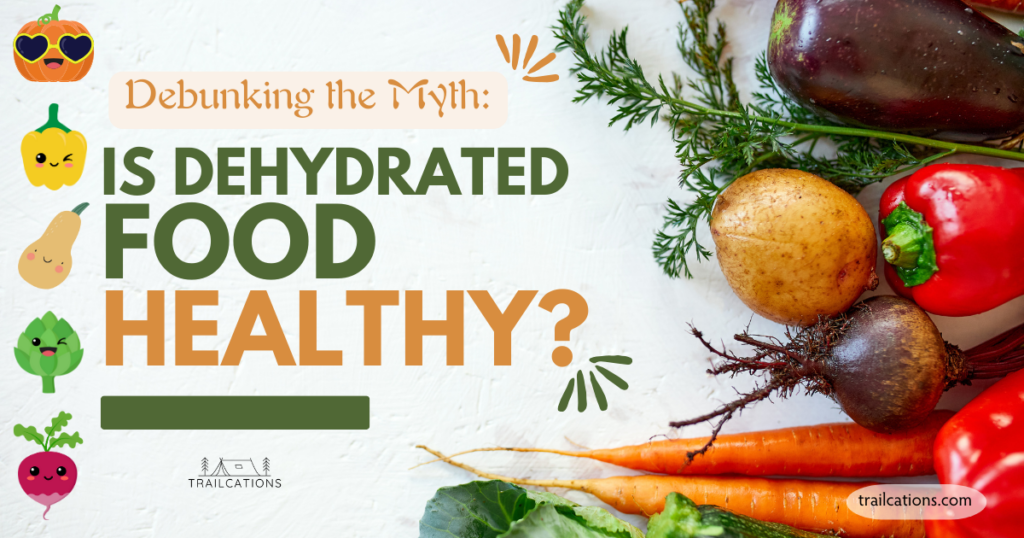
How Does Dehydrating Affect Nutrition?
Dehydrated food is a convenient and cost-effective way to preserve food. The dehydration process removes water from the food, which inhibits the growth of bacteria and other microorganisms that cause spoilage.
Dehydrated food can last for months or even years if stored properly. Dried foods are often used in backpacking, camping and emergency food supplies. They are lightweight, easy to prepare and have a long shelf life.
Furthermore, dehydrated fruits and vegetables are a healthy snack option and a great source of vitamins, minerals, and fiber. They can be eaten on their own or added to salads, camping meals, oatmeal, baked goods and smoothies.
Unfortunately, a few nutrients are lost during the dehydration process, such as Vitamin C. It is important to consume dehydrated fruits and vegetables in moderation unless you are very active. Dehdyrated foods are higher in natural sugars and calories than fresh produce.

Key Takeaways
- Dehydrated food is a convenient and cost-effective way to preserve food.
- Dehydrated foods are a good source of vitamins, minerals, and fiber. However, some nutrients are lost during the dehydration process.
- A food dehydrator can help you create healthier versions of store-bought dried foods.
- 11 Tips to ensure your dehydrated food is safe to eat.
- Nutritional content comparison of dehydrated foods vs. other preservation methods.
- How Does Dehydrating Affect Nutrition?
- Understanding Dehydrated Food
- What is the Food Dehydration Process?
- How Many Nutrients Are Lost When Dehydrating Food?
- What is the Healthiest Food to Dehydrate?
- Food Dehydrators & Healthy Home Dehydrating
- What Happens If You Dehydrate Food Too Long?
- Health Benefits of Dehydrating Food
- Is it Safe to Dehydrate Food?
- What Is The Healthiest Food Preservation Method: Canning, Freezing, Freeze-Drying vs. Dehydrating
- Are Dried Foods Considered Processed?
- What Are the Advantages of Dehydration Over Drying?
- Is Dehydrated Food Still Considered Raw?
- Frequently Asked Questions

Understanding Dehydrated Food
Dehydrated food is a type of food that has had its moisture content removed through the process of dehydration. The food dehydration process involves removing water from fresh food. Dehdyrators use heat to evaporate moisture and airflow to blow away the humid air. The resulting dehydrated, or dried, food shrinks down to a fraction of its original weight and volume. Dried food retains the majority of nutrients, antioxidants and fiber content.
Despite dehydrated food can be a healthy and convenient option, is dehydrated food actually healthy?
Dried food is often low in fat and calories and can be stored for long periods of time without spoiling. However, it is important to be aware that the dehydration process can slightly alter the nutritional content of the food.
It is important to follow proper food dehydrating techniques to ensure that your dehydrated food is healthy and safe to eat. This includes blanching or pretreating certain foods before dehydrating them to help prevent the growth of harmful microorganisms. It is also important to dehydrate food at the correct temperature and for the correct amount of time. These factors ensure that your dried food is healthy, fully dehydrated and safe to eat.

Is Dehydrated Food Good For You?
When answering the question “Are dehydrated foods good for you?”, it’s important to distinguish between commercial (aka store-bought) dehydrated food and home dried food.
Is Home Dehydrated Food Healthy?
Home dehydrated food can be very good for you. You control the amount of salt, sugar and preservatives that go (or don’t go!) into your dried ingredients.
The dehydrating process naturally concentrates flavor, nutrients and fiber content. Consequently, a cup of dried carrots has significantly more nutritional value than the same amount of fresh carrots.
However, dehydrated food also has more calories than its fresh counterparts. So, unless you’re very athletic or have a high metabolism, it’s wise to go easy on the dehydrated snacks.
Also, certain water-soluble nutrients like Vitamin C naturally deteriorate when dehydrated. However this can be mitigated at home by pretreating your food in citric acid prior to dehydrating.

Is Commercial (Store-bought) Dehydrated Food Healthy?
Commercial dehydrated food can be a good option for certain situations, such as camping or emergency food supplies. It is lightweight, easy to store, and has a long shelf life. However, it is important to note that most store-bought dehydrated food contains high levels of sodium, sugars and preservatives. Highly processed dried food is lower in certain nutrients compared to fresh and home dried foods. It is also important to choose dehydrated food that is minimally processed and does not contain added sugars or preservatives.
Before buying dried food at the store, make sure to check the ingredients list. Ask yourself, “Is this dehydrated food healthy?” If you see preservatives you can’t pronounce or high levels of sugar and salt, find an alternative option.
How to Use Dehydrated Foods for Healthy Snacks and Meals
Adding dehydrated fruits, vegetables and meats to rice, grain or pasta dishes greatly increases nutrients. Dried, powdered vegetables and fruits can also be added to smoothies for a power-packed punch. On their own, dried fruits, vegetables and meats can be delicious and nutritious snacks. However, be cautious of how calorific they are, especially if you are not very active.
Overall, dehydrated food is a healthy, convenient option if it isn’t prepared with excessive preservatives. However, since some vitamins are depleted and calorie content is increased with dehydrated food, it should not be relied on as the sole source of nutrition. Instead, dried food should be used to supplement fresh ingredients.
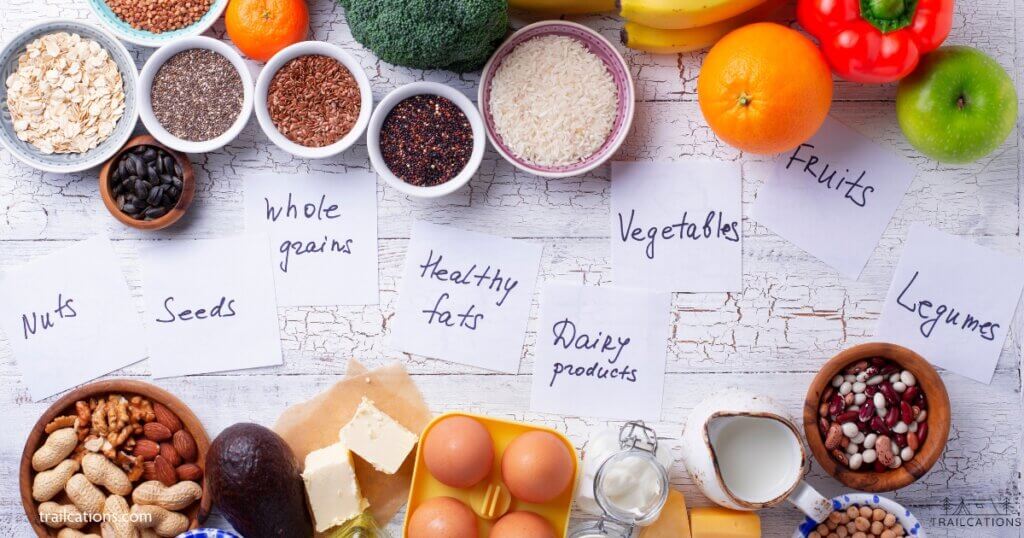
Why Is Dehydrated Food Important?
Dehydrated food is important for many reasons. The process of dehydration shrinks food down to a fraction of its volume and weight by removing moisture. This allows it to become shelf stable. The compact dried food is easily transported huge distances to feed people who may not have access to healthy food. Advances in dehydrated food over the years have fed victims of natural disasters, militaries across the globe and rural communities.
Dehydrated food is a healthy and convenient option for those looking to extend the shelf life of their food. Dried food also helps you reduce food waste and save money by preserving excess produce.
Almost all of the nutritional value is retained in dehydrated food. Due to low drying temperatures, the dehydration processes loses very little nutritional value. Compared to other food preservation methods like canning and freezing, dehydration comes out on top.
By understanding the process of dehydration and following proper techniques, you can enjoy delicious and nutritious dehydrated food at home. Dehydrated food is a healthy way to preserve your bountiful garden harvest, store extra meat from a hunting trip or grow your pantry stores for your family or next backcountry adventure.
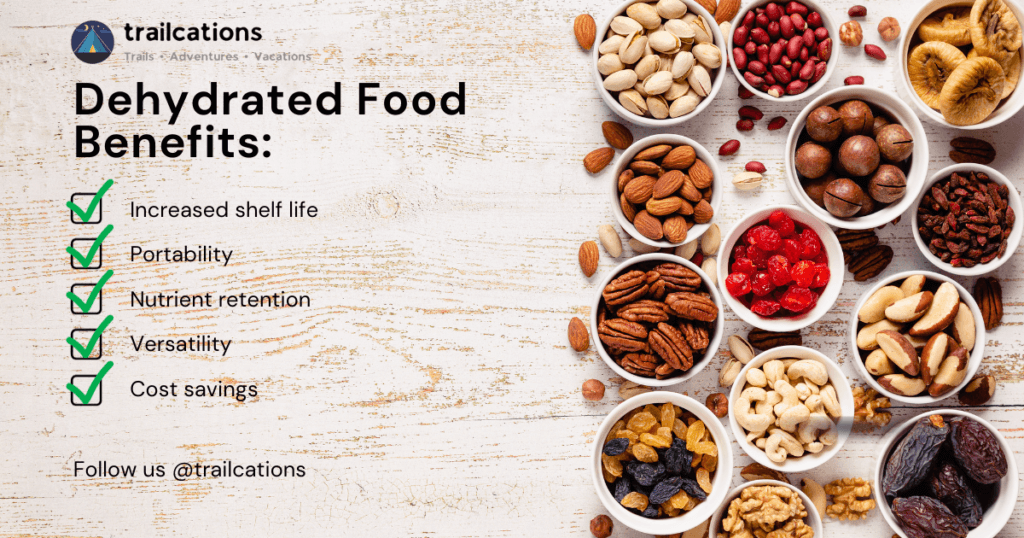
What Are the Benefits of Dehydrated Foods?
There are many benefits of dehydrated food, so much so that we wrote a whole article about it: 49 Benefits of Dehydrating Food.
Here are five additional benefits of dehydrated foods:
- Increased Shelf Life: Dehydrated foods can last for months or even years when stored properly. This makes them a great option for long-term food storage.
- Portability: Dehydrated foods are lightweight and compact, making them ideal for camping, hiking, and other outdoor activities.
- Nutrient Retention: Dehydration preserves many of the nutrients in food, including vitamins, minerals, and enzymes. These can be lost during other forms of food preservation like canning and freezing.
- Versatility: Dehydrated foods can be used in a variety of recipes, from soups and stews to snacks and desserts.
- Cost Savings: Dehydrating food at home can be a cost-effective way to preserve excess produce. Dehydrating can help you clean out the fridge, preserve garden harvests or take advantage of fresh produce sales.
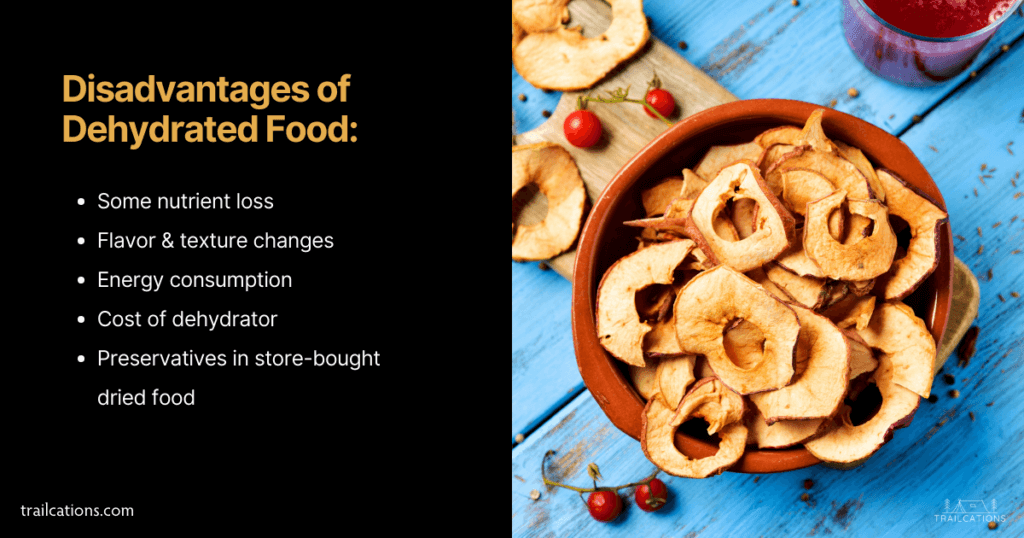
What Are the Disadvantages of Dehydrated Foods?
Despite the health benefits, there are a few disadvantages of dehydrated foods. Here are five disadvantages of dehydrating food:
- Nutrient Loss: While dehydration preserves many nutrients in food, some vitamins and minerals are lost to the drying process.
- Flavor and Texture Changes: Dehydrated foods can have a different flavor and texture than their fresh counterparts. Some people may find the taste and texture of dehydrated foods less appealing than fresh foods. Other methods of preservation that retain flavor and texture better include freeze-drying, spray-drying and for some foods, freezing.
- Energy Consumption: Dehydrating food requires energy, whether it’s in the form of electricity or gas. This can be a concern for people who are trying to reduce their energy consumption. It can also be impossible for people who live in areas with limited access to energy sources.
- Cost of a Dehydrator: A dedicated food dehydrator can be fairly costly for some people. Higher end dehydrators can cost several hundred dollars but tend to provide lots of drying capacity and high quality results.
- Preservatives in Commercial Dehydrated Food: Dehydrated food sold in stores must comply with governmental food safety regulations. Inevitably, this means some dehydrated food (ex: meat) must include preservatives whose benefits in preventing bacteria growth outweigh the addition of chemicals. Many commercial dehydrated foods actually contain high levels of sugar (ex: dried fruit), salt (ex: dried meals) and preservatives (ex: jerky) so check your ingredients before buying.
In our opinion, the advantages of dehydrated food greatly outweigh the disadvantage of dehydrated foods. However, continuing reading to determine if dehydrated food is healthy and the right choice for you.
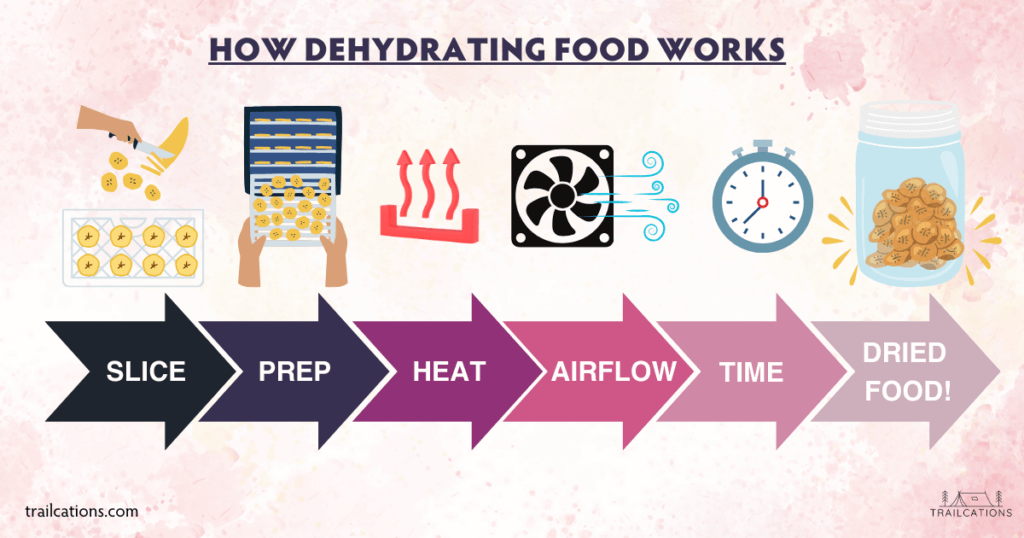
What is the Food Dehydration Process?
Food dehydration is a preservation process in which moisture is removed from foods, thereby extending shelf-life and preserving nutrients. This is done by using low heat, which evaporates the water content in the food, while maintaining its nutritional value. The process is achieved primarily by using a food dehydrator, a device specifically designed to dry out food at optimal temperatures for preservation.
Dehydrating is a reliable preservation method used for over 14,000 years to help extend the shelf life of food. Drying food makes it more compact for storage and transport. This process concentrates the flavor and nutrient value of a food, making dehydrated food healthy and tasty.
Dehydration can be achieved through a variety of methods, including sun drying, oven drying and using a food dehydrator. Each method has its advantages and disadvantages. The choice of method will depend on the type of food being dehydrated and the resources available.

What is the Main Purpose of Dehydration of Food?
The main purpose of dehydration of food is to remove the moisture from the food. This helps to increase an food’s shelf life by inhibiting the growth of microorganisms that cause spoilage.
Dehydrated foods are also lighter and more compact than fresh or canned foods, making them easier to transport and store. Additionally, dehydrated foods can be used in a variety of ways, such as rehydrated in soups, stews, and casseroles. Alternatively it can be simply eaten whole as a snack such as veggie chips, fruit leathers and jerky.
Dehydration also helps to preserve the nutritional value of the food. The majority of vitamins and minerals are not affected by the low temperatures of the drying process. Dehydrated food is one of the healthiest ways to retain nutrients of fresh ingredients compared to freezing and canning.
Since ancient times, people have used dehydration to preserve the excesses of the harvests and hunts for leaner times. Modern day food dehydration preserves food for backpackers, hikers and outdoor adventurers in a compact and shelf-stable manner.
Dehydrated food also provides nutrition to relief efforts, militaries and rural areas where transporting fresh food isn’t economically or logistically feasible. The dehydration of food helps home gardeners prolong bountiful harvests, hunters to preserve game meat and preppers to stockpile resources.
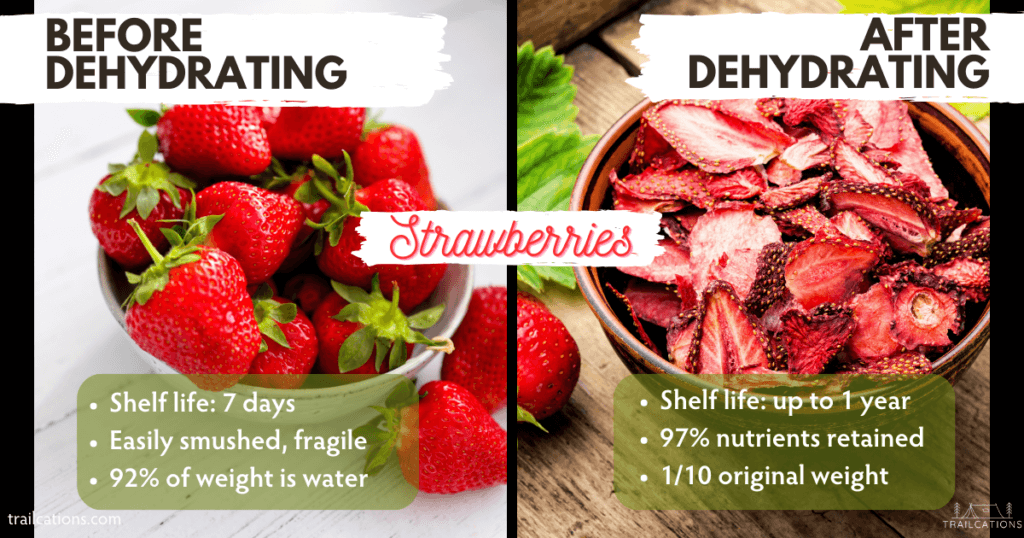
How Does Dehydrating Food Help Preserve It?
Dehydrating food helps preserve it by removing the moisture from the food. This is key in stopping the growth of microorganisms like bacteria, yeasts and mold that cause spoilage. These microorganisms require moisture to grow and reproduce. By removing the water from the food, their growth is slowed down or completely stopped. This means that dehydrated foods have a longer shelf-life than fresh foods.
In addition to inhibiting the growth of microorganisms, dehydration also slows down the oxidation process that can cause food to spoil. Oxidation occurs when oxygen in the air reacts with the fats and oils in food. This causes food to become rancid and develop off-flavors. By removing the water (H2O) from the food, dehydration reduces the amount of oxygen available to react with the fats and oils. No oxygen means the oxidation process slows down, preserving the flavor and quality of the food.
Dehydration also helps to preserve the nutritional value of the food. Many vitamins and minerals are not affected by the low temperatures of the drying process. However, it is worth noting that some water-soluble nutrients, such as Vitamin C, are lost during the dehydration process. To restore nutrients lost to the preservation process, you can actually pretreat food with a Vitamin C solution. This pretreatment process will ensure that a dehydrated food is healthy and provide maximum nutritional content.
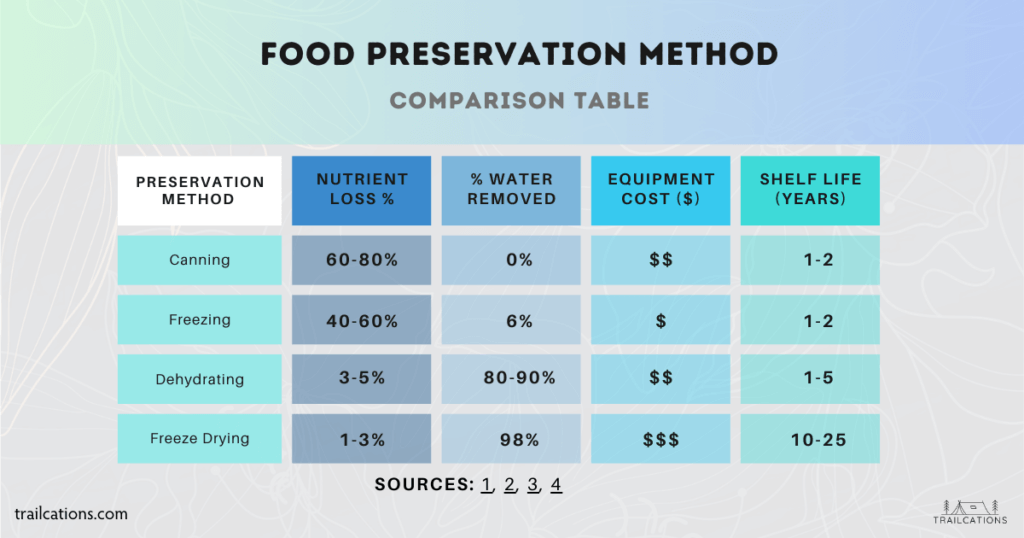
How Many Nutrients Are Lost When Dehydrating Food?
Luckily for home dehydrating enthusiasts, the amount of nutrients that are lost when dehydrating food are very minimal. Dehydrating retains the most nutrients compared to other food preservation processes like canning and freezing.
Compared to other methods of food preservation, dehydrating is one of the top ways to preserve nutrients. The low drying temperatures don’t cook the nutrients out of the food. This means dehydrated food is healthy and one of the most reliable ways to preserve the nutrition fresh ingredients.
Nutrient loss by food preservation method (1):
- Canning: 60-80% nutrient loss
- Freezing: 40-60% nutrient loss
- Dehydrating: 3-5% nutrient loss
- Freeze-drying: 1-2% nutrient loss
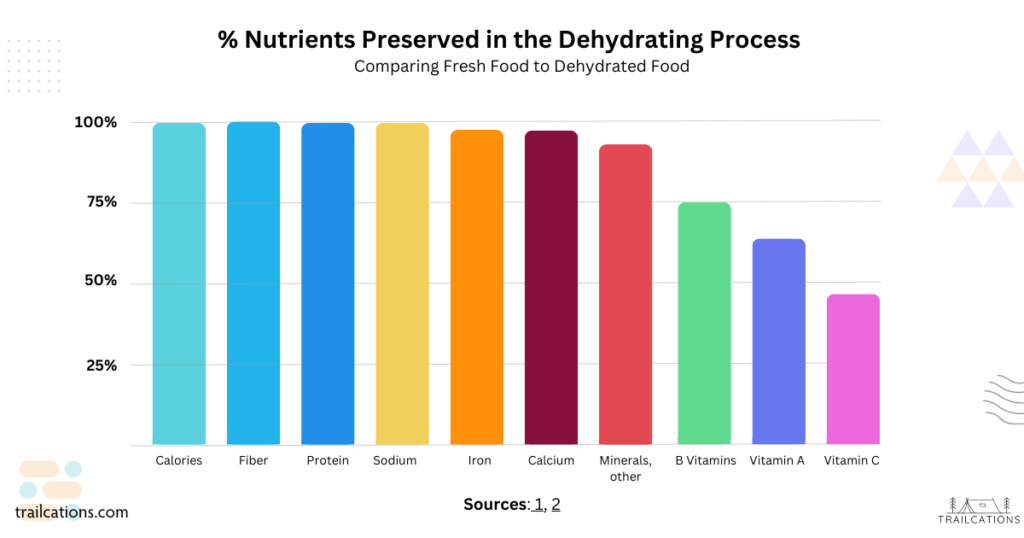
Does Dehydrating Preserve Nutrients?
Of all of the many food preservation processes, dehydrating is one of the top methods that preserves the most nutrients. Only a few water-soluble vitamins, antioxidants and nutrients are lost to the dehydration process such as Vitamin C, Vitamin A and beta carotene. However, most of these nutrient losses can actually be fixed with some pretreatment and appropriate dehydrating temperatures.
Like all methods of food preservation, dehydrating results in minor loss of nutrients. Nutritional changes that occur during dehydrating include:
- Vitamin C: Mostly destroyed during drying and blanching. Can be remedied by pretreating in ascorbic acid solution (Vitamin C).
- Vitamin A: At high temperatures it is destroyed but under controlled heat and appropriate temperatures it is fairly well retained.
- Niacin, Riboflavin, Thiamin: Minor loss during blanching. Can be better retained if liquid used for rehydrating is consumed.
- Minerals: Some lost during rehydrating if soaking liquid isn’t consumed.
- Iron: Not destroyed.
- Fiber: No effect.
- Calories: Does not change but becomes more concentrated into smaller area.
For the best nutrient retention in dehydrated foods, always store in an airtight container in a cool, dark, dry place. Consume within a year for optimal nutrients and quality.
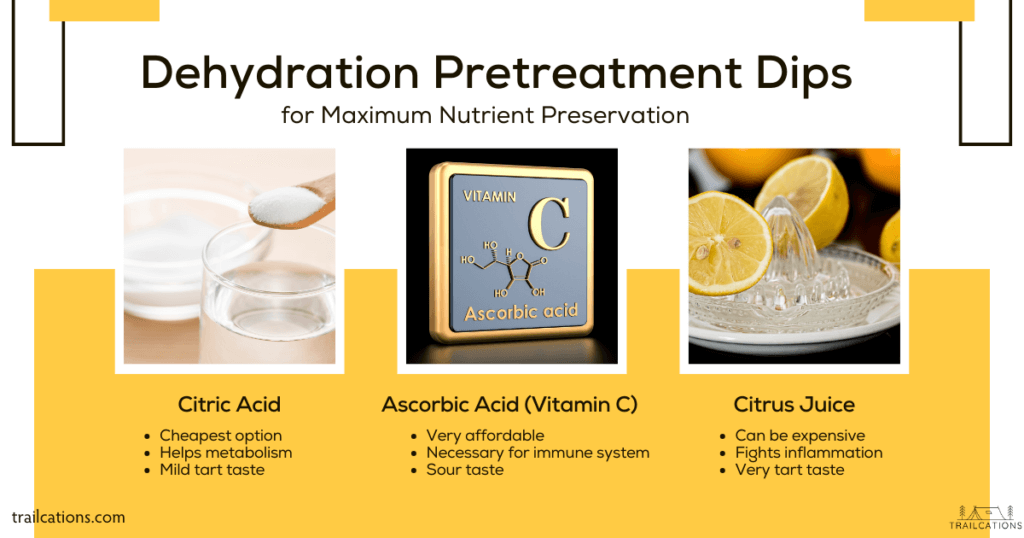
How to Preserve the Most Nutrients When Dehydrating
Studies have shown that the best way to preserve delicate antioxidants and nutrients are by drying foods at the appropriate temperatures. Never dehydrate food at higher temperatures to speed up dehydrating as research shows that it destroys nutrients.
Since Vitamin C is the nutrient that degrades the most during dehydration, a creative solution to preserving this heat–sensitive vitamin is by pretreating produce. Prior to dehydrating, dip produce in a solution of citric acid, ascorbic acid (Vitamin C) powder or citrus juice. This increases the amount of Vitamin C that survives the dehydrating process.
Plus, this acidic pretreatment has been shown to kill off bad bacteria more effectively than dehydrating alone. Pretreating food is a surefire way to keep dehydrated food healthy and safe to eat long term.
How Nutritious is Dehydrated Food?
Dehydrated food can be very healthy and nutritious. The drying process helps retain many of the vitamins, minerals and other nutrients found in fresh food. However, the nutrient content of dehydrated food can vary depending on several factors. This includes the type of food, the method of dehydration, how the food is stored and preparation methods.
Dehydration can help to preserve many of the nutrients in food, including vitamins, minerals, fiber and antioxidants. However, some nutrients, such as vitamin C, are lost during the dehydration process. This happens if the food is exposed to too high temperatures or light.
To maximize the nutritional value of dehydrated food, it is important to use fresh, high-quality produce. Always use the temperatures recommended in your food dehydrator manual. It is also important to store and prepare dehydrated food properly. Exposure to moisture, heat, or light can cause further nutrient loss.
Overall, dehydrated food can be a nutritious addition to a balanced diet. It is particularly effective when combined with other healthy foods such as fresh fruits and vegetables, whole grains, and lean proteins.
How Healthy is Dehydrated Food? Are Dehydrated Foods Healthy?
Dehydrated foods are healthy options, but it depends on the specific type of food and how it is prepared. Here are some factors to consider:
- Nutritional Value: Dehydrated food can retain many of the vitamins, minerals, and other nutrients found in fresh food. However, some nutrients, such as vitamin C, can be lost during the dehydration process.
- Ingredients: It is important to choose dehydrated foods that are made with high-quality ingredients. Avoid commercial dried food that contain added preservatives or other additives.
- Preparation: How dehydrated foods are prepared can also impact their healthfulness. For example, home dried fruits and vegetables can be a healthy snack option. Store-bought dehydrated meats or processed snacks may be high in sodium, added sugars and unhealthy fats.
- Portion Size: Pay attention to portion sizes when consuming dehydrated foods,as they are high in calories. It is also important to balance dehydrated foods with other healthy foods. These include fresh fruits and vegetables, whole grains and lean proteins.
Overall, dehydrated food is a healthy addition to a balanced diet, particularly when made with high-quality ingredients and consumed in moderation. However, it is important to read labels and pay attention to portion sizes to ensure a nutritious diet.
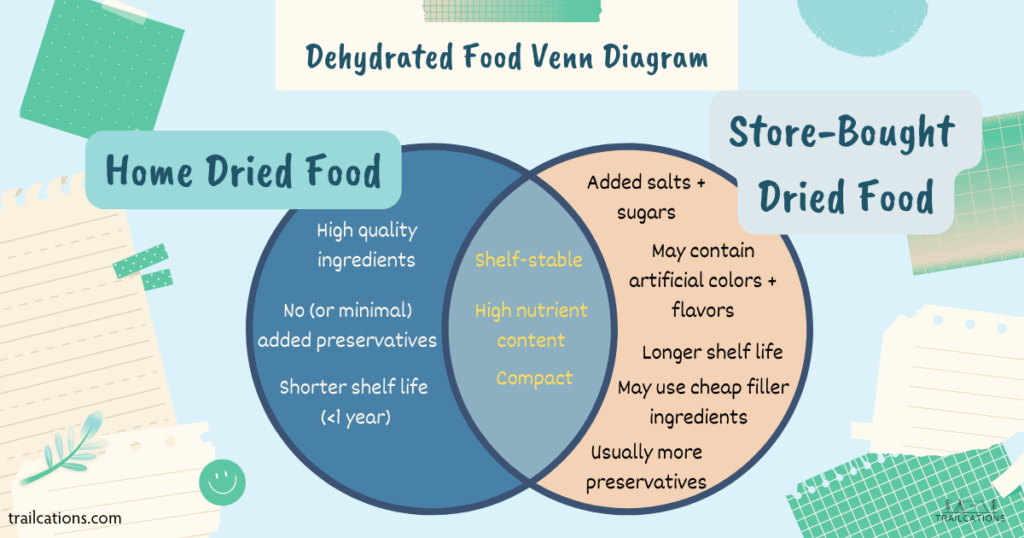
Is Dehydrated Food Unhealthy?
Dehydrated food can be considered unhealthy if excessive sugar, salt, preservatives and ultra-processed ingredients have been added to the food.
Dehydrating concentrates the amount of nutrients in a food, losing only about 3-5% to the drying process. However, dehydrated food also contains significantly more calories when compared to its fresh counterparts. Unless you are a very active individual, it might be wise to consumed dehydrated food in moderation.
On average, home dehydrated food tends to be more healthy than its commercial counterparts. With home dehydrating, you can add as many or as few additives to your foods as you desire.
Overall, commercial dehydrated food tend to be more unhealthy than homemade dried food. Due to strict USDA and FDA regulations, commercial dehydrated food must meet certain food preservation standards. Therefore, it may contain more preservatives and chemicals than homedried food. Also, many large food companies are concerned about profit margin so they use cheap ultra-processed ingredients to improve palatability, shelf-life and appearance. Always check ingredients to avoid excessive salts, sugars and preservatives.
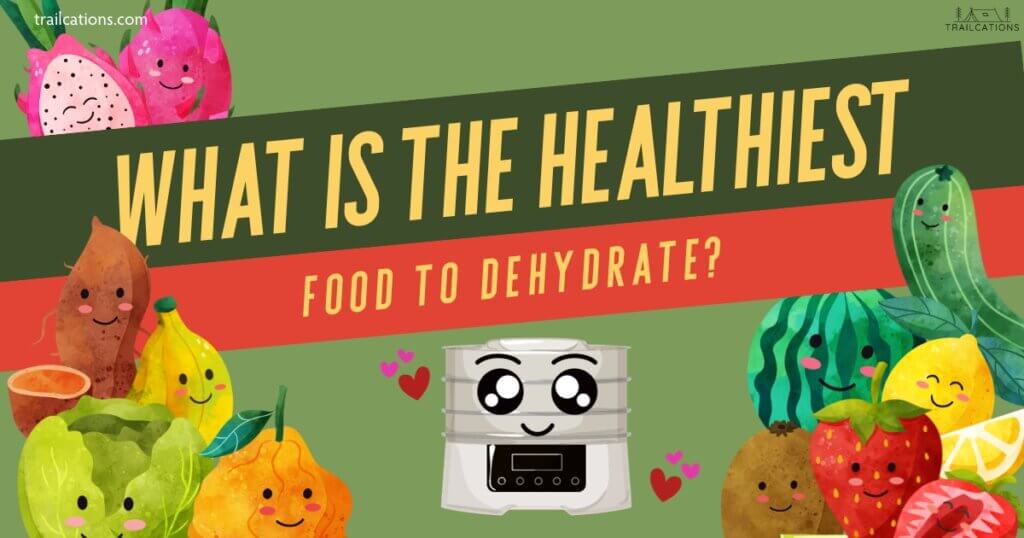
What is the Healthiest Food to Dehydrate?
There is a wide variety of healthy foods that can be dehydrated, including fruits, vegetables, meats, mushrooms and herbs. Each type of food requires a different temperature and duration for proper dehydration. By experimenting with various settings, you’ll find the perfect balance to achieve your desired results.
Some popular healthy food items to dehydrate are:
- Fruits: apples, bananas, berries, mangoes, pineapples
- Vegetables: tomatoes, bell peppers, mushrooms, onions, kale, beets, sweet potatoes
- Meats: lean beef (less than 10% fat), chicken, turkey, fish (less than 5% fat)
- Mushrooms: crimini, morels, white button, lion’s mane, matsutake
- Herbs: basil, parsley, oregano, rosemary, mint, ginger
By learning the art of food dehydration, you’ll be able to enjoy the convenience and health benefits it offers while making the most out of your food purchases. Home dehydrated food is healthy and a rewarding activity that can save you money and reduce waste in the long run.
Stuck on what the healthiest foods are to dehydrate? Check out our article (and FREE downloadable PDF!) about 500 Foods You Can and Cannot Dehydrate for ideas!
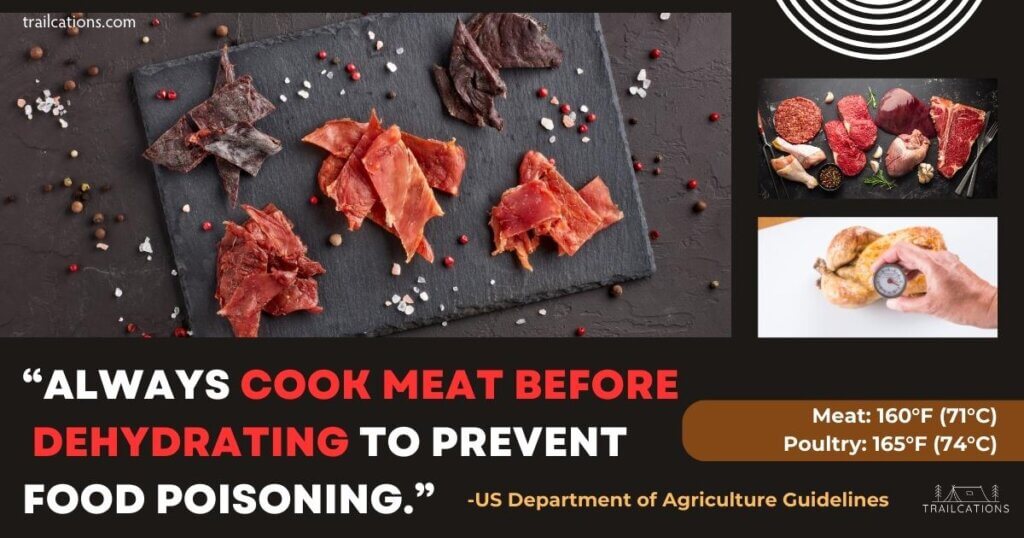
Are Dehydrated Meats Healthy?
Dehydrated meats, such as jerky, are very healthy if prepared correctly and food safety protocols have been followed. Lean cuts of meat, poultry and fish are used for dehydrating. This means there is very high protein content and low fat content in home dried meat. However, store-bought dehydrated meats can contain high levels of salts and preservatives so it’s best to consume in moderation.
Home Dried Meats Safety Protocols
The USDA recommends all home dehydrated meats to first be cooked to 160°F (71°C) and 165°F (74°C) for poultry to kill off E. coli and other food poisoning microorganisms. Next, dehydrator temperatures must be kept at a minimum of 140°F (60°C). The USDA recommends storing home dried meats for 1 to 2 months in the refrigerator or pantry. Never marinade home dehydrated meats in oil-based marinades as the oil can become rancid and spoil.
Having gotten food poisoning from poorly prepared home dehydrated meat, we always follow the USDA guidelines now. Spending 4 days of getting sick in the woods on a hiking trip was lesson enough for me. Today I am much more discipline in following USDA dehydrating guidelines. Since then, I have never gotten sick from home dried food.
Preservatives in Commercial Dehydrated Meats
Commercial dehydrated meats can contain high levels of salt as well as industry standard preservatives such as sodium nitrites that prevent bacterial growth. Nitrites occur naturally in vegetables and even in your saliva in higher doses than what is found in preserved meats. However, many global studies have shown that the benefits of sodium nitrites in preventing deadly botulism bacteria growth outweigh the small risk of toxicity in extremely high doses.
Keep in mind that some jerky preservatives such as sodium erythrobate preserve flavor but in rare cases cause allergic reactions. Levels of sodium nitrites and other preservatives in dehydrated meats are strictly controlled by government regulations. With the high levels of salts found in dried meats, it’s wise to consume them in moderation.

What Are the Best Meals to Dehydrate?
The best meals to dehydrate contain low fat or fat free ingredients. These include vegetables, grains, herbs, lean meats and plant-based meat). For best quality, dehydrated meals are assembled from individually dried ingredients (ex: rice dried separately from beans). Alternatively, they can be dehydrated already pre-mixed (ex: rice + beans mixed together and spread out on a single tray).
There are so many fantastic meal choices to dehydrate that the possibilities are endless. From global cuisines to allergen-free meals to dietary preferences, the dehydrated meal world is your oyster!
Make sure you only dehydrate lean, low-fat ingredients and follow food safety protocols. There are so many delicious, healthy meal recipes you can safely dehydrate. Dehydrated food is healthy, compact and shelf stable. Home dried meals are perfect for hiking, camping or having on hand for when you don’t feel like cooking!
Some of our favorite dehydrated meal recipes are:
- Unstuffed Peppers: peppers, onion, garlic, rice, tomatoes, basil, oregano, lean ground beef
- Mushroom Risotto: mushrooms, arborio rice, onion, garlic, walnuts, white wine, basil, thyme, chicken bouillon, freeze-dried parmesan
- Keto Chicken Curry: chicken, rice cauliflower, broccoli, red bell pepper, tomato powder, curry powder, garlic, cinnamon, cumin, ginger, coconut milk powder
- Vegan Thai Peanut Noodles: homemade Thai peanut sauce, bell peppers, carrots, onions, garlic, ginger, rice noodles, soy curls, sesame seeds
- Backpacker Chili Mac: lean ground beef, bell pepper, jalapeño, onions, garlic, beans, fire roasted tomatoes, chili powder, macaroni
- Gluten-Free Marinara Pasta: homemade tomatosauce powder, onions, garlic, basil, carrot, thyme, parsley, brown rice noodles
- Hash Brown Breakfast Casseroles: hash brown style potatoes, low fat sausage, shredded zucchini, mushrooms, green onions, Italian seasoning, freeze-dried egg powder, spray-dried milk powder
Avoid dehydrating milks, eggs and cheese as dehydrating is too slow of a preservation process to safely dry these foods. Instead, opt for purchasing freeze-dried or spray-dried powders which are typically very affordable and certified to be safe to consume.
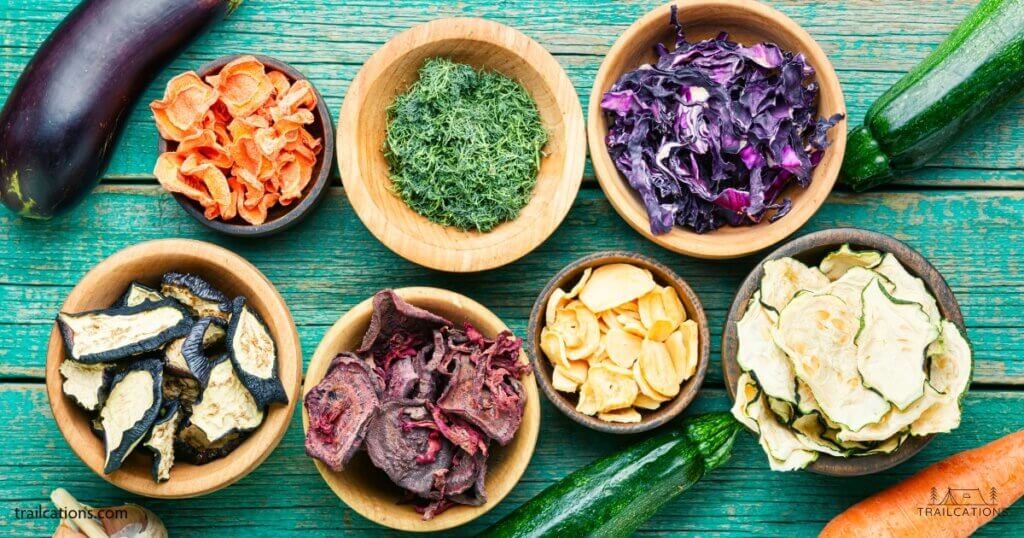
Are Dehydrated Fruits and Vegetables Healthy?
From Fresh to Dehydrated
Dehydrated fruits and vegetables are made by removing the water content from fresh produce. This inhibits the growth of microorganisms and slows down the process of spoilage. Dehydration can be achieved using a food dehydrator, an oven, or sun drying. Blanching, or pretreating the produce in a citric acid solution before dehydrating, can help preserve the color and nutrients.
Nutritional Value of Dehydrated Fruits and Vegetables
Dehydrated fruits and vegetables retain most of their nutrients, including vitamins, minerals, and fiber. However, the dehydration process can cause some nutrient loss, particularly vitamin C. Some store-bought dehydrated fruits and vegetables may also contain added sugars and preservatives. These additives can increase the calorie, sugar and sodium content of a dried food.
Health Benefits and Risks of Dehydrated Produce
Dehydrated fruits and vegetables can provide a convenient and portable source of nutrition year-round. They can be used in smoothies, as snacks, or rehydrated for cooking. Home dehydrating foods is healthiest as you can control what exactly goes into the foods.
However, consuming too much commercial dehydrated food with added sugars and preservatives can contribute to weight gain. It also increases the risk of heart disease, cancer and diabetes. Additionally, dehydrated food may not provide the same level of hydration as fresh produce due to its lower water content. Store-bought dehydrated food is healthy if it doesn’t contain lots of added ingredients.
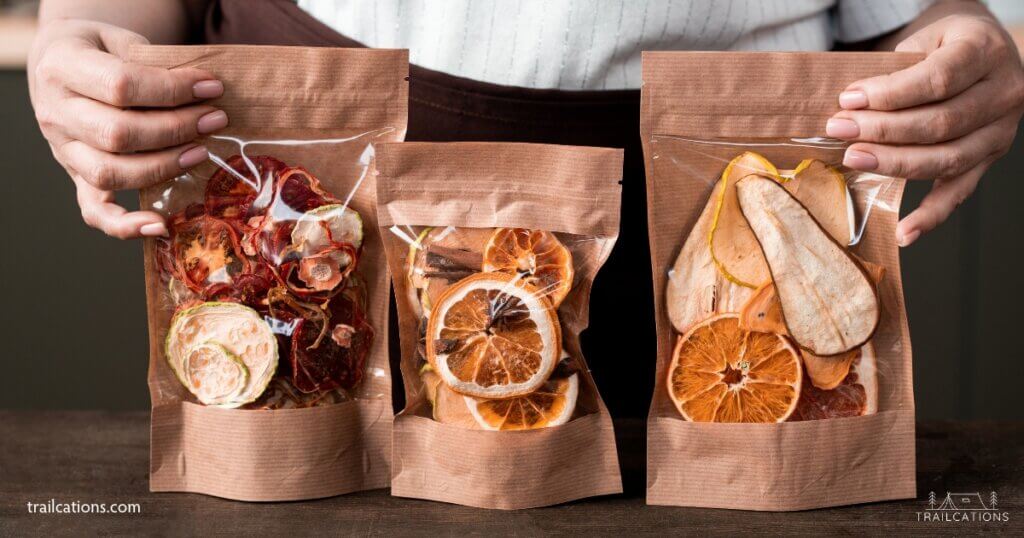
Comparing Fresh and Dehydrated
Fresh produce is generally considered healthier than their dehydrated counterparts due to their higher water content and lower calorie content. However, dehydrated fruits and vegetables are great options when fresh produce is not available or in season. They also have a longer shelf life and take up less space than fresh produce.
Nutrient Loss in Dehydrated Food
The dehydration process can cause some nutrient loss, particularly vitamin C. However, dehydrated fruits and vegetables can still be a good source of vitamins, minerals, and fiber. It is important to choose dehydrated fruits and vegetables without added sugars and preservatives to ensure the dehydrated food is as healthy as possible.
Storage and Shelf Life
Store dried food in a cool, dry place in an airtight container to prevent moisture and insect infestations. They can last for several months to a year if stored properly. This shelf stable, compact and long shelf life food is perfect for hikers, campers and backpackers alike adventuring in the backcountry.

Uses of Dehydrated Fruits and Vegetables
Use dehydrated fruits and vegetables in a variety of ways from snacks to meals. Some recipe ideas include veggie chips, trail mix, toppings for oatmeal or yogurt or rehydrated for cooking. Blend and dry fruit into fruit leather or grind veggies into powder for smoothies. We love supplementing store-bought noodle, rice and grain dishes with a packet of mixed veggies to make a more nutritionally complete, healthy dehydrated food meal.
Dehydrating at Home
Dehydrating fruits and vegetables at home can be a cost-effective and easy way to preserve produce. Use a food dehydrator, oven or solar dryer to dehydrate produce. Blanching or pretreating with an acidic solution like citrus juice before dehydrating can help preserve the color and nutrients. Home dehydrated food is healthy and tends to be more nutritious than store-bought dried food.
Sugar and Sodium Content
Some commercial dehydrated fruits and vegetables may contain added sugars, salts and preservatives, which can increase their calorie and sodium content. It is important to choose products without added sugars, salts and preservatives to minimize the risk of weight gain and heart disease. Dehydrated food is healthiest with minimal added ingredients.
Fat and Energy Content
Dehydrated fruits and vegetables are generally low in fat and calories. However, some products may contain added sugars and preservatives, which can increase their calorie content. It is important to read labels and choose products without added sugars and preservatives.
Hydration and Dehydrated Food
Dehydrated fruits and vegetables have a lower water content than fresh produce and may not provide the same level of hydration. It is important to drink plenty of water and consume a variety of fresh fruits and vegetables to maintain proper hydration.
Advantages of Dehydrated Produce
Dehydrated fruits and vegetables can provide a convenient and portable source of nutrition year-round. They have a longer shelf life and take up less space than fresh produce. Dehydrating at home can be a cost-effective and easy way to preserve produce that is in season, on sale or ready for harvest in your garden.
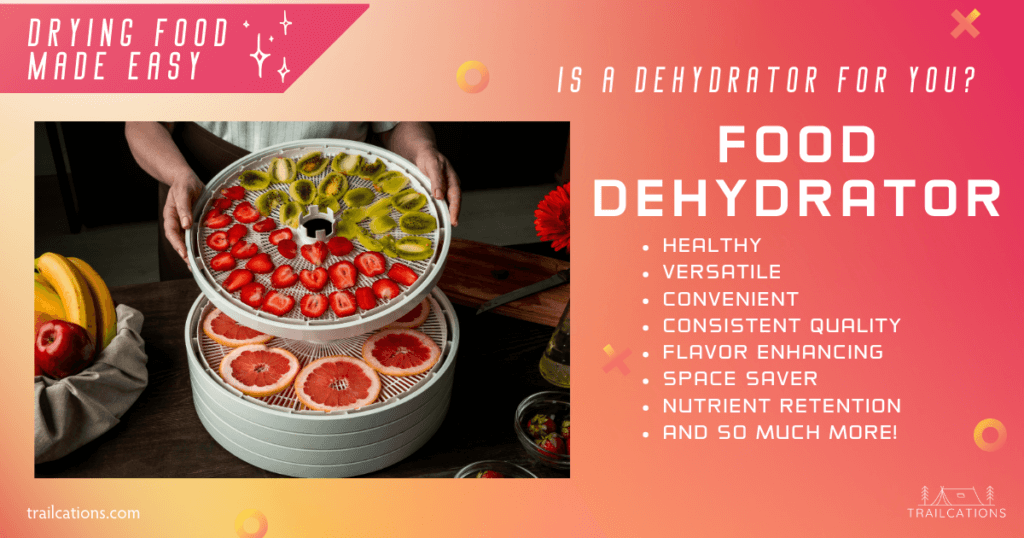
Food Dehydrators & Healthy Home Dehydrating
Food dehydrators are a popular choice for home use, as they are easy to use and can dehydrate a wide range of foods. They work by circulating hot air around the food, which removes the moisture and helps to preserve it. Food dehydrators come in a variety of sizes and styles. Use these appliances to dehydrate fruits, vegetables, meats, and more.
What are the Advantages and Disadvantages (Pros & Cons) of a Food Dehydrator?
Advantages of a Food Dehydrator
A food dehydrator is a useful appliance to have at home to dry your food. Although there are other methods to dehydrate food like oven drying, air fryers and sun drying, they aren’t always consistent or efficient. Comparing other methods of food preservation like canning and freezing, a food dehydrator offers some significant benefits to nutrient content and flavor. These appliances make sure your dehydrated food is healthy every time.
Here are some advantages of a food dehydrator:
- Consistency: A food dehydrator provides consistent results. Food dries evenly.
- Convenience: A food dehydrator is easy to use. Some models can be left unattended during the drying process. This frees up time for other activities.
- Preservation: A food dehydrator can help preserve food for longer periods of time, reducing waste and saving money.
- Nutrient Retention: A food dehydrator can preserve many of the nutrients in food, including vitamins, minerals, and enzymes. Other forms of food preservation lose significantly more nutrients.
- Versatility: Use it to dry a wide variety of foods, from fruits and vegetables to meat and fish. The variety of foods it can dry makes it a versatile tool in the kitchen.
- Space Saving: A food dehydrator can be a space-saving alternative to canning or freezing, as it takes up less space in the pantry or freezer.
- Flavor Enhancement: Drying food can intensify the flavor of certain foods, such as tomatoes and herbs, making them more flavorful and delicious.
Disadvantages of a Food Dehydrator
Although a food dehydrator does have many benefits, it may not always be the best purchase for those with limited storage space or who live off the grid. Here are some disadvantages of a food dehydrator:
- Cost: A food dehydrator can be expensive to purchase, especially if you’re looking for a high-quality model. Low budget models cost under $100 whereas higher quality models can cost several hundred dollars.
- Energy Consumption: A food dehydrator requires electricity to operate, which can add to your energy bill. However, in the US it currently costs anywhere from $0.56 to $1.97 per drying cycle. Comparatively speaking, dehydrating the same amount of food in an oven or air fryer would cost up to 10x more.
- Noise: Some food dehydrators can be noisy while in operation, which can be a concern if you’re trying to use it in a shared living space. Currently, our loudest dehydrator operates at about the same decibel level as a laundry drying machine so we put it in another room and close the door when it’s running.
- Time: Dehydrating food can be a time-consuming process, especially if you have a large amount of food to dry. It can take several hours or even days to fully dry some foods, especially if you live in a humid environment.
- Limited Capacity: A food dehydrator has a limited capacity, which means you can only dry a certain amount of food at a time. This can be a concern if you have a large amount of food to dry, for instance from a bumper crop of food in your garden.
- Maintenance: A food dehydrator requires regular cleaning and maintenance to ensure that it continues to work properly. However, some food dehydrators have dishwasher-safe trays to make for easier cleanup.
Is a Dehydrator Good or Bad for You? Are Food Dehydrators Healthy?
Some people are curious to whether a dehydrator is good or bad for you. From over 10 years of experience using a dehydrator, the benefits of having a pantry full of healthy, preservative-free meals and snacks greatly outweighs any negatives.
Sure, it can be annoying to have to clean your dehydrator after using it or needing to rotate trays every so often to promote even drying. Sometimes we find out the hard way that dehydrating strong-smelling food like jalapeño peppers without opening the windows is effectively like releasing a giant canister of pepper spray in your house. But, having access to a reliable, energy-efficient way to quickly preserve excess garden produce or locally harvested wild game has been a game changer.
Dehydrators Help Avoid Excessive Food Additives
The benefits of having a food dehydrator are too numerous to list. However, our little drying appliances have saved us thousands of dollars over the years compared to buying the same dried ingredients from the store. Plus, the preservative-free, high nutritional content of the home dried food has kept us healthy and injury-free on thousands of miles of hiking, biking and paddling trips.
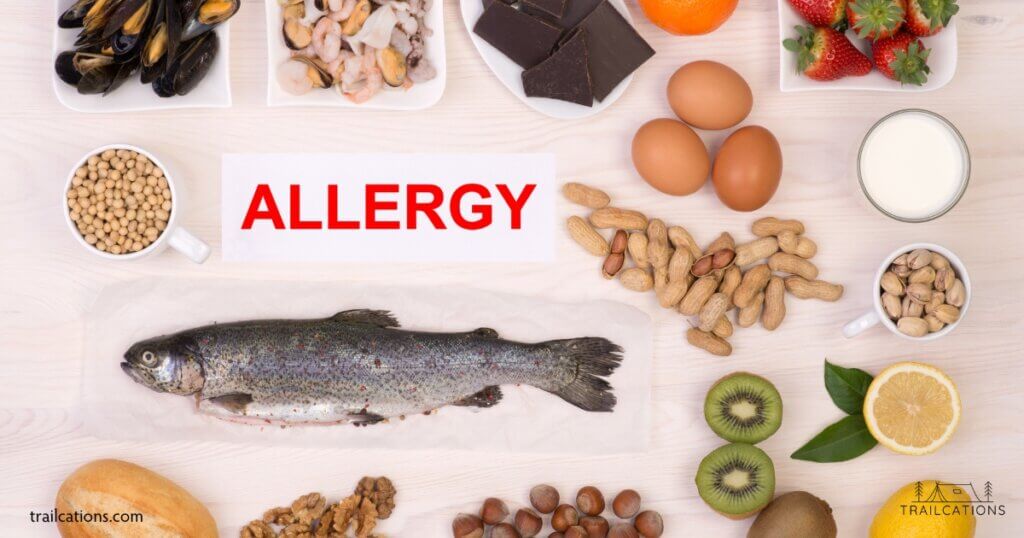
Why Food Dehydrators are Great for People with Food Allergies and Sensitivities
Since we live in a family with a couple different food sensitivities, a food dehydrator has been such a great appliance for us to have. There’s no worries about having to read ingredients and searching the internet to find if we might react to different additives. Our home dehydrated food is healthy and helps us consume allergen-free meals and snacks without worrying.
Preventing Food Waste (and Saving Money!)
For us, a food dehydrator has saved us from wasting food and saves us money on buying new ingredients. When forgotten produce in our fridge starts to lean towards wilting, we rescue it and give it new life in our dehydrator.
Honestly, it’s a matter of opinion but for us personally we tend to think having a food dehydrator is good decision for us. Our home dehydrated food is healthy, preservative-free, allergen-free and helps us save money by increasing shelf life and having to reduce grocery store trips.
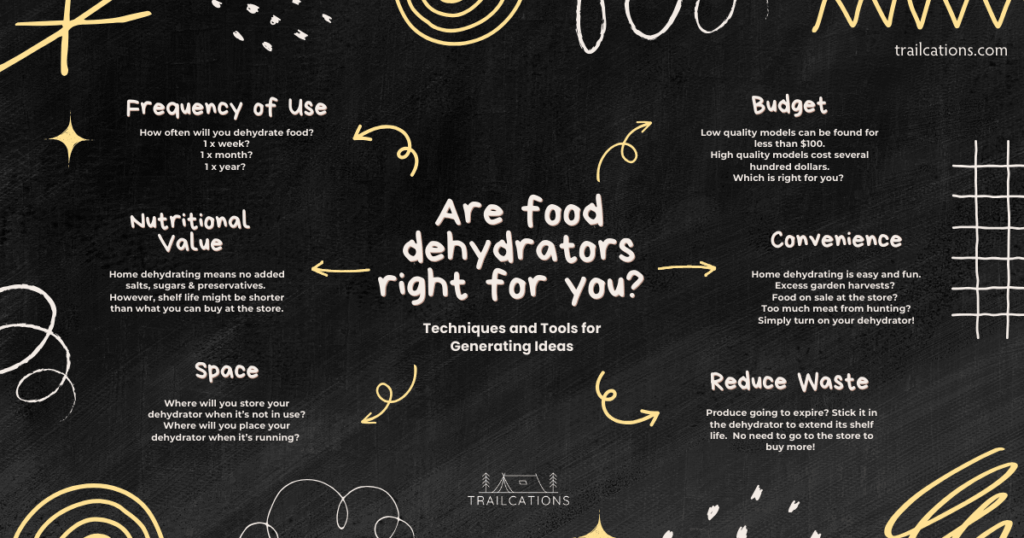
Is it Worth Buying a Food Dehydrator?
Whether or not it is worth buying a food dehydrator depends on your individual needs and preferences. Here are some factors to consider:
- Frequency of Use: If you plan on using a food dehydrator frequently to preserve food or make snacks, it may be worth the investment. We use ours 1 to 3 times per week to preserve food for hiking and backpacking trips so it was worthwhile to invest in a dehydrator.
- Cost: Food dehydrators can range in price from around $70 to several hundred dollars. Consider your budget and how much you are willing to spend on a food dehydrator.
- Space: If you have limited space in your kitchen or home, a food dehydrator may not be worth the investment.
- Nutritional Value: It preserves the nutritional value of a food without added preservatives.
- Convenience: If you are looking for a convenient way to preserve food or make snacks, a food dehydrator can be a great option.
Overall, a food dehydrator can be a worthwhile investment if you plan on using it frequently and have the space and budget for it. It can be a cost-effective way to preserve excess produce, make healthy snacks and add variety to your diet.
What are the Food Dehydrators to Make Your Own Healthy and Tasty Food?
When you dehydrate food, you make it less susceptible to spoilage by stopping the growth of bacteria, molds and yeasts that can cause foodborne illnesses. This is because these microorganisms require water to grow and survive, and by removing it from the food, you create an inhospitable environment for them. A food dehydrator is the most reliable and effective way to make your own healthy and tasty dried food.
There are many options to purchase a food dehydrator. Some of the more well known brands of food dehydrators to make your own healthy and tasty food are:
- Excalibur
- Nesco
- Presto
- Cabela’s
- Cosori
- Ronco
- Weston
- Cuisinart
- LEM Products
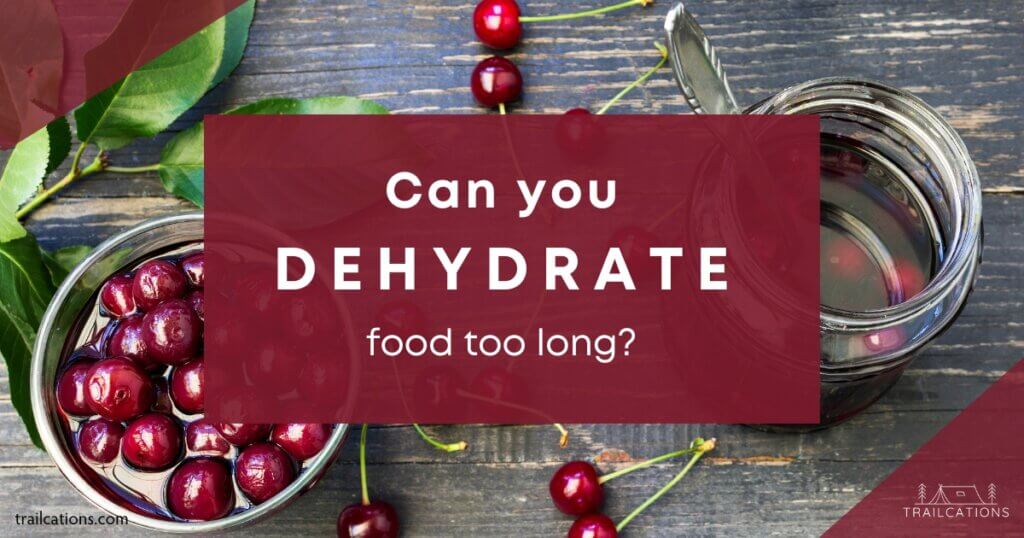
What Happens If You Dehydrate Food Too Long?
Have no worries if you dehydrate food too long! Especially with an adjustable thermostat food dehydrator, it is practically impossible to overdry your ingredients. We have left our food dehydrator on overnight, during the work day or when we go to run errands. The end result always turns out great in our adjustable thermostat food dehydrator, even if we run the dehydrator 4 or more hours longer than planned.
It’s very difficult to “overdry” a food when the dehydrator uses the correct drying temperature.
For instance, dehydrating fruit like apple slices at 125°F (52°C) usually takes us 6 to 12 hours in the humid environment of Minnesota. Sometimes when a rain storm is on its way, the humidity in the air is so high that after 12 hours of dehydrating the apples are still not dry. So, I’ll add on another few hours to the dehydrator timer just to make sure they’re completely dry.
However, at a certain point the amount of moisture in the food levels out and unless you change the dehydrator temperature, humidity or atmospheric pressure, no more moisture will be able to escape from the food. There are some physics, organic chemistry and heat transfer equations involved but in laymen’s terms, this means if you keep the dehydrator temperature at the same 125°F (52°C), it’s practically impossible to “overdry” a food.
It is much better to overdry a food than under dry. You cannot safely put overly moist food in long term storage. Too much moisture encourages the growth of mold, yeast and bad bacteria responsible for food poisoning.
When to Be Concerned About Overdrying
The only time you should be concerned about dehydrating your food too long is when you’re using a fixed thermostat dehydrator. They have a single temperature setting around 160°F (71°C). People typically use these inexpensive dehydrators for making beef jerky.
Dehydrate herbs, fruits and vegetables at much lower temperatures than 160°F (71°C) to optimize nutrient content and flavor. Be aware that if you leave these in your fixed temperature dehydrator for too long, your delicate produce will cook, burn and even start smoking.
How do we know this? Once upon a time, I almost burnt my in-laws cabin down using their fixed thermostat dehydrator for drying fruit. Come to find out 160°F (71°C) really is NOT the best temperature to dry thin fruit slices and walk away for a few hours. (Hopefully J + S you will never read this!) Always keep a close eye on your fixed temperature dehydrator, rotating individual pieces of food and trays around every couple of hours.
If you’re still concerned about overdrying your food, purchase an adjustable thermostat food dehydrator with a timer so the appliance shuts off after the set drying period.
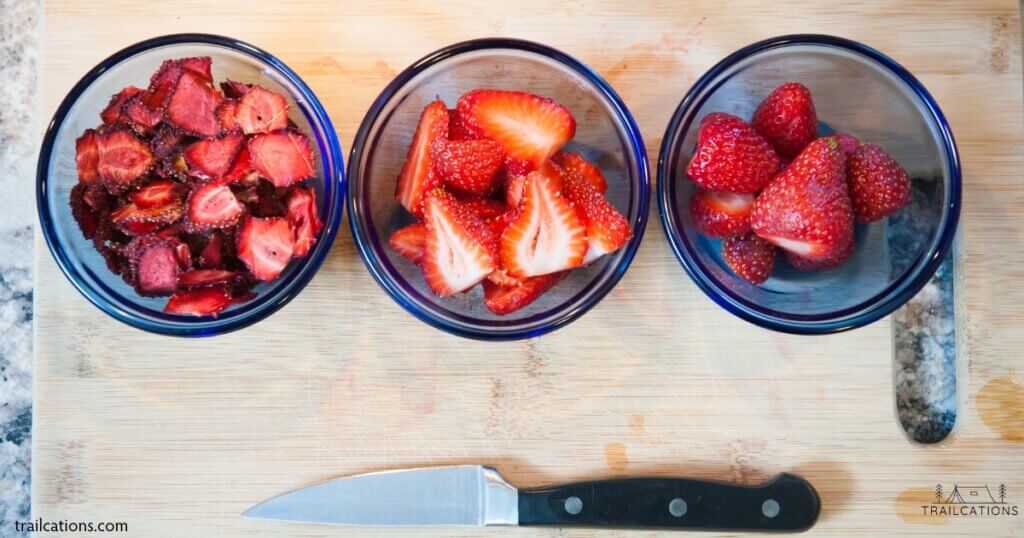
Health Benefits of Dehydrating Food
There are several health benefits that you can enjoy by incorporating dehydrated food into your diet. In this section, we will explore various advantages ranging from the preservation of nutrients to becoming a cost-effective and sustainable food option.
Preservation of Nutrients
One major perk of dehydrating food is that it helps retain the original vitamins, minerals, and natural enzymes of the food better than other forms of food preservation or cooking methods. By dehydrating your food, you can maintain its nutritious quality, providing important nutrients for your overall health.
Better Digestion and Weight Loss
Dehydrated foods often have a concentrated amount of fiber, which aids digestion and keeps you feeling full for longer. This can contribute to weight loss by keeping your appetite in check and leading to fewer instances of unhealthy snacking.
Increased Shelf Life
Dehydrating food can vastly extend the shelf life of your fruits, vegetables, and meats. The removal of water and moisture inhibits the growth of bacteria and preserves the food for longer periods, making it a practical method for storing food – especially when perishable items are difficult to keep fresh.
Cost-Effective and Sustainable Food Option
Dehydrated food is not only resourceful, but it’s also cost-effective. By opting for this method, you can reduce food waste and save money by purchasing seasonal produce when it is in abundance and preserving it for future use. Drying your own food at home also helps reduce the environmental impact of food transportation.
Is it Safe to Dehydrate Food?
It is very safe to dehydrate food these days. With over 14,000 years of food dehydrating knowledge combined with modern food safety protocols, making and eating dehydrated foods have never been safer.
However, poorly prepared dehydrated food can cause food poisoning (or worse). We don’t want to scare you but instead make you aware of how important food safety is when dehydrating food.
Having first-hand experienced food poisoning from poorly prepared home dried food, we want to ensure you avoid repeating our mistakes. It’s important to us that you have good dehydrating food experiences.
For maximum food safety when dehydrating food at home, following basic food safety protocols such as washing your hands can go a long way. Keeping dehydrated food healthy and safe should be your #1 priority when home dehydrating.
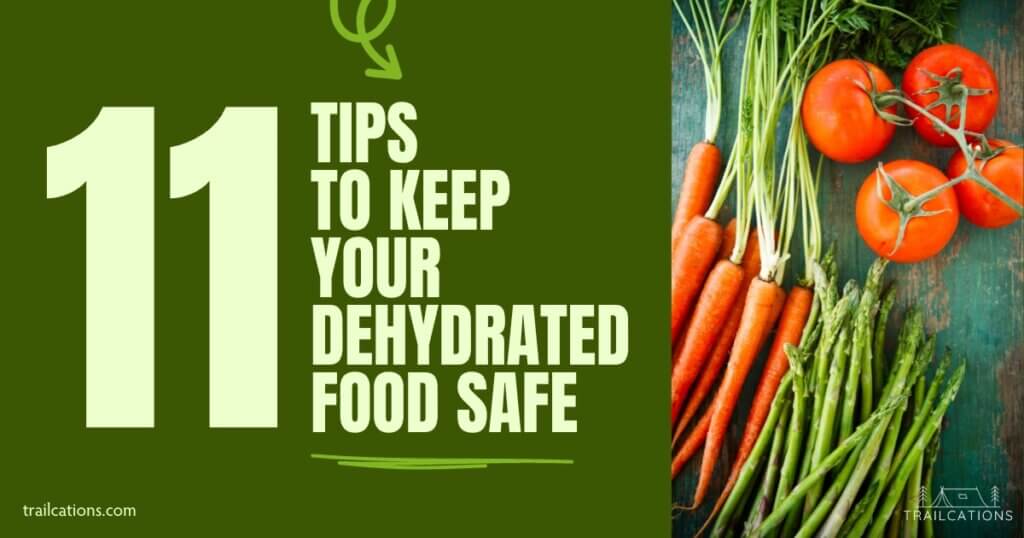
11 Tips to Keep Your Dehydrated Foods Safe
Here are some other food safety procedures you can follow when dehydrating food to ensure your ingredients are safe:
- Wash all produce thoroughly and use only the freshest ingredients.
- Dehydrate foods at the correct temperatures and length of time.
- Cook meat prior to dehydrating to eliminate harmful microorganisms.
- Never dehydrate high fat or oily ingredients.
- Avoid cross-contamination and wash your hands and all surfaces prior to prep work.
- Consider pretreating your food with citric acid to reduce bad bacteria and botulism growth.
- After dehydrating, condition food in airtight containers (like mason jars) for 3 to 7 days to check for moisture.
- Label dehydrated food with drying date, expiration date and name of the ingredient.
- Store food in airtight containers in a cool, dark, dry place.
- Throw out the entire batch of dried food if there are signs of moisture or mildew in long term storage.
- Clean your dehydrator after every use.
Learn more about how to easily clean your dehydrator here: How to Clean Your Dehydrator: A Step-by-Step Guide.
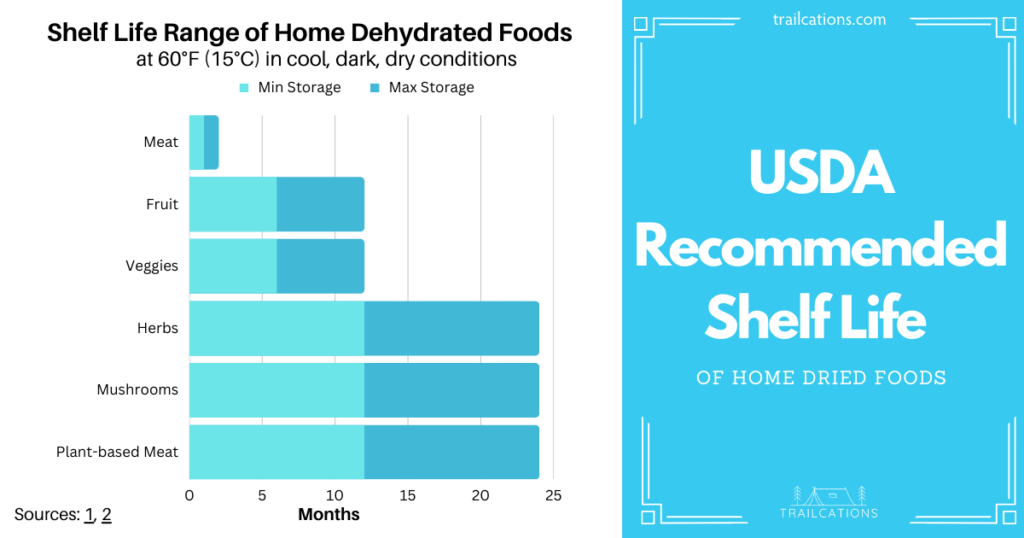
How Long is Dehydrated Food Safe?
How long dehydrated food is safe is highly dependent on if you store the food in airtight containers in a dark, dry and cool place (less than 60°F or 15°C). If your food ever shows signs of moisture, smells “off” or has mold on it, you should immediately throw out the whole batch of food in the container.
The United States Department of Agriculture and Colorado State University Extension (a top research-based authority for home dehydrating in the USA), recommend that home dehydrated food shelf-life is as follows:
- Home dried meats, fish and jerky: 1-2 months if stored in the refrigerator or pantry
- Dried fruit, fruit leathers: 6 to 12 months if stored in the fridge or pantry. 1 month if stored at room temperature after opening.
- Dried vegetables: 6 to 12 months if stored in fridge or pantry.
- Dried herbs: 1-2 years
- Dried mushrooms: 1-2 years if stored in pantry. 3 months if stored in pantry after opening.
- Dried plant-based meats: 1-2 years if stored in pantry. 3-4 months if stored in pantry after opening.
To achieve the longer end of the shelf life spectrum, it’s critical to store dehydrated foods somewhere with minimal exposure to oxygen, moisture and light. Pro Tip: Two ways to extend the shelf life of your dehydrated foods are: vacuum sealing and adding an oxygen absorber.

Can You Get Sick from Dehydrated Food?
Although rare, it is possible to get sick from dehydrated food. Typically food poisoning from dehydrated food comes from not following research-based food safety processes such as washing your hands.
The Rare Risk of Food Poisoning
With lax food safety processes, dried food can easily become contaminated with mold, yeast or bacteria such as E. coli, Listeria or Salmonella that cause food borne illness. If you’ve never had food poisoning, consider yourself lucky. It is an experience I would never wish on anyone.
Botulism: Very Rare But Important To Recognize Symptoms
The worst case scenario is that the infamous bacteria Botulism grows on your food. Farming soil across the globe contains botulism spores. Luckily, you can eradicate botulism by following basic food safety procedures. It is more common in home canning gone wrong than dehydrating.
Although rare in dehydrating, the airtight storage space of dehydrated food is the perfect environment for the nerve-damaging and potentially deadly Botulism to reproduce. If you’re just getting into food dehydrating, it might not be a bad idea to familiarize yourself with Botulism symptoms.
Always make sure that you follow food safety procedures and quality checks to ensure your food is completely dry before placing in long-term storage.
Editor’s Note on Personal Experience with Dehydrated Food Poisoning
Having gotten food poisoning from dehydrated food I made at home when first starting out over 10 years ago, I would highly recommend erring on the side of caution and sticking to USDA, FDA and other research-based food dehydrating protocols.
I spent 4 days at the beginning of my 6 month Appalachian Trail thru-hike in the backcountry with food poisoning. The culprit was dried fatty ground beef that wasn’t cooked thoroughly before dehydrating.
Luckily the severe diarrhea, debilitating cramps, nausea and headaches weren’t enough to warrant a backcountry rescue. However, the awful experience was definitely not something I would wish on anyone. It was an important lesson to become much more diligent in preparing dehydrated food.
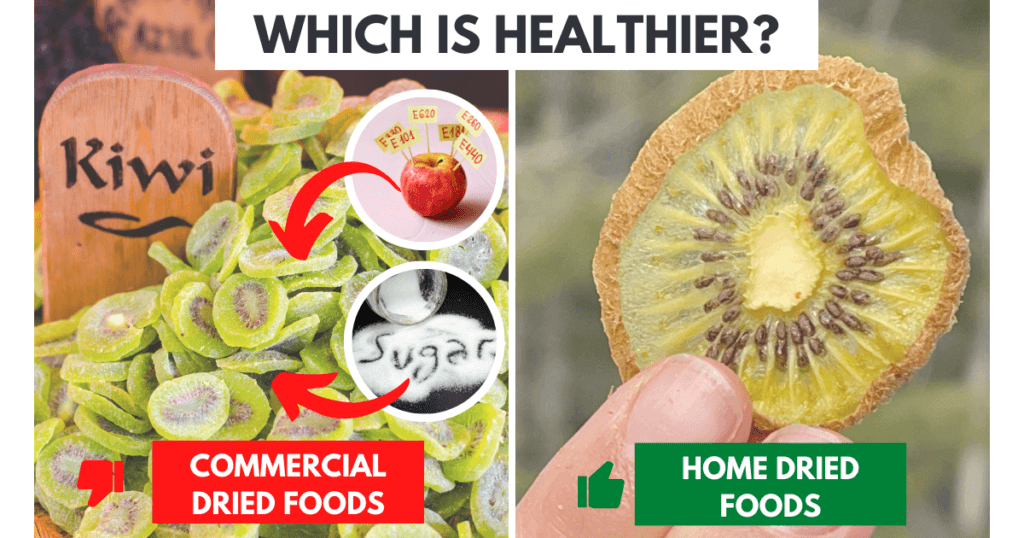
Is Dehydrated Food Still Healthy?
Even after dehydrating, food is still extremely healthy. The low and slow temperatures of the dehydration process ensure that minimal vitamins, minerals and nutrients are lost. When compared to other preservation methods like cooking, canning and freezing, dehydrating comes out on top in terms of nutrient retention.
Store-bought vs. Homemade Dehydrated Food: Which is Healthier?
Store-bought dehydrated food can be healthy but many brands use added ingredients like preservatives, artificial flavors, salt and sugar to increase shelf-life, improve flavor and save money on ingredient costs.
For maximum health benefits, always check the ingredients on any store-bought dehydrated food. Reading ingredient labels ensures that your food is free of unhealthy added sugars, salts and cheap filler ingredients.
Minimally processed dehydrated foods tend to be the healthiest to consume. In fact, dehydrating food at home is the best way to know what added ingredients go (or don’t go!) into your dehydrated food. Luckily it seems that with recent healthy eating trends, more brands are selling dehydrated foods with minimal added ingredients.
Why Checking Dehydrated Food Ingredients is Important
For instance, many dehydrated fruits purchased at the store contain incredible amounts of sugar and preservatives.
Take Ocean Spray Dried Cranberries (I am partial to cranberries because I worked on a cranberry farm once). In a 40 gram (1/4 cup) serving of “The Original” Ocean Spray Cranberries available at most grocery stores, there are over 26 grams of added sugar! Despite being over half of your recommended total daily sugar intake, 66% of the dried cranberries aren’t actually berries at all – they’re pure sugar!
Many light-colored dehydrated fruits like apples and pears contain sulfites which prevent the food from oxidizing, or turning brown, during the dehydration process. For example, sodium metabisulfite is a fairly common dried fruit preservative. However, research has shown that it may cause allergic reactions in people with asthma. Yikes!
Always check dehydrated food ingredients when buying food at the store. At home, you have more control of what ingredients you add to your dried foods. Keep in mind that some dehydrated food preservatives like citrus juice may actually improve shelf life without damaging nutrient content (or your health)!
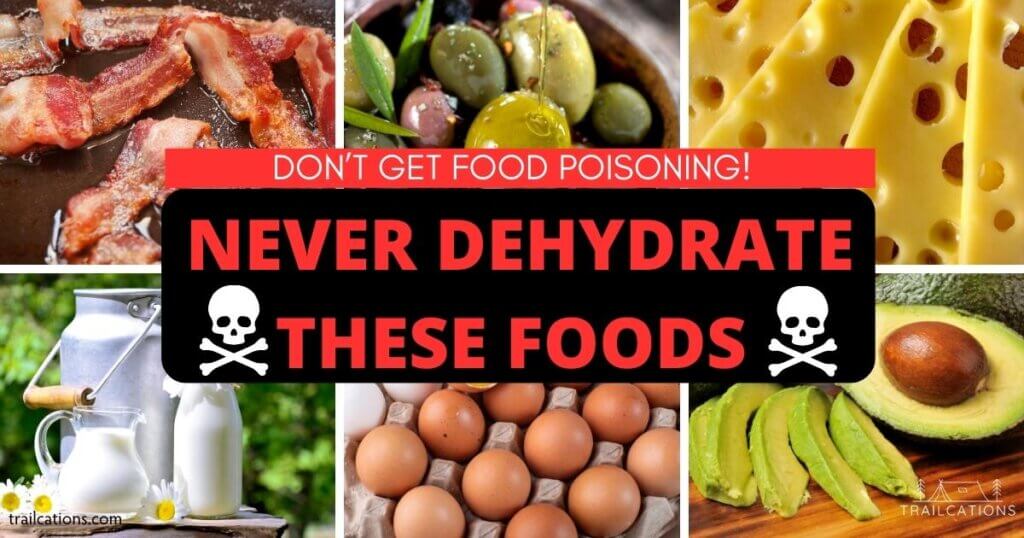
Is there Anything You Cannot Dehydrate?
You cannot safely dehydrate foods that are high in fat content or oily. Ingredients that are high in fat or oily are not suitable for dehydration. Oily foods can preserve bad bacteria ranging from those that cause food poisoning to deadly botulism. It is best to avoid dehydrating fatty or oily foods and opt for an alternative preservation method such as freeze-drying or spray drying.
- What fruit cannot be dehydrated? – Avocado, olives
- What vegetables cannot be dehydrated? – All vegetables are good for drying.
- What meats cannot be dehydrated? – Do not dehydrate any meats with more than 10% fat content and oily fish with more than 5% fat content.
- What nuts and seeds cannot be dehydrated? – You can dehydrate nuts and seeds BUT you can’t store these long term at room temperature due to their high oil content. These must be stored in the fridge or freezer to prevent spoilage.
- What herbs cannot be dehydrated? – All herbs are good for drying.
- What mushrooms cannot be dehydrated? – All mushrooms are good for drying. Some have better texture than others.
- Other: Do not dehydrate any dairy, cheese or eggs. Even low-fat or fat free dairy will spoil and easily
Want to learn more? Check out 500 foods You Can and Cannot Dehydrate (plus our free downloadable PDF guide!)

What Is The Healthiest Food Preservation Method: Canning, Freezing, Freeze-Drying vs. Dehydrating
Dehydration provides several advantages over other food preservation methods, such as freezing or canning. One of the main benefits is that it reduces the weight and bulk of the food, making it easier to store and transport. Additionally, it concentrates flavors and aromas, enhancing the taste of the dehydrated food items. Comparatively, dehydration retains almost 97% of nutrients compared to a meager 40-60% of nutrient retention in freezing and only 20-40% of nutrients retained in canning (1).
“USDA tests demonstrate that dehydrated foods lose only 3-5% of nutritional value — mostly vitamin C and vitamin A. Compare with canning (60-80% loss) or freezing (40-60% loss). When you dehydrate your own food there are no additives or damaging high temperatures.”
US Department of Agriculture Research Services Division, Composition of Foods – Handbook No. 8, Analysis Charts Table 2 – Nutrients In The Edible Portion Of One Pound Of Food
Is It Better to Can or Dehydrate?
Whether it is better to can or dehydrate food depends on your individual needs and preferences. Here are some factors to consider:
- Nutritional Value: Both canning and dehydrating can preserve the nutritional value of food, but dehydrating preserves more nutrients (95-97%) compared to canning (20-40%) as it does not involve cooking the food at high temperatures.
- Convenience: Dehydrating food is often more convenient than canning. Drying requires less equipment. It can be done in smaller batches. Canning requires more equipment and can be a time-consuming process.
- Shelf Life: Both canning and dehydrating can extend the shelf life of food, but canned food typically lasts longer than dehydrated food.
- Flavor and Texture: Dehydrated food can have a different flavor and texture than canned food. Some people may prefer the taste and texture of canned food, while others may prefer dehydrated food.
- Cost: Dehydrating food is often a more cost-effective option than canning per batch. Drying does not require as much equipment.
- Weight and Volume Reduction: Dehydrating reduces food down to a fraction of the weight and size of the fresh ingredients, making it compact and portable, perfect for activities like backpacking. Canning adds weight to the fresh ingredients.
Overall, whether it is better to can or dehydrate food depends on your individual needs and preferences. Both methods have their advantages and disadvantages, and the best choice will depend on factors such as the type of food you want to preserve, your available equipment, and your personal preferences.
Does Canning or Dehydrating Preserve More Nutrients?
In terms of nutrient preservation, dehydrating easily wins the competition as it preserves up to 97% of vitamins, minerals and nutrients due to the low temperatures used. Since canning requires high temperatures to ensure food safety, it actually cooks the food resulting in only 20 to 40% of nutrients preserved (1).
Does Dehydrated Food Last Longer Than Canned?
The USDA recommends consuming home canned foods within 1 year. Consume home dehydrated food within 1 year if stored at temperatures below 60ºF (15ºC). Vacuum sealing and oxygen absorbers can increase shelf life of dehydrated food.
Does Home Canning Destroy Nutrients?
Home canning can destroy some nutrients in food, particularly heat-sensitive vitamins such as vitamin C and some B vitamins. The high temperatures used in the canning process cause these vitamins to break down. Canning doesn’t affect some nutrients, such as fiber.
To minimize nutrient loss during canning, it is important to follow proper canning procedures and use fresh, high-quality produce. The USDA recommends consuming home canned foods within one year. After that, nutrient loss increases over time.
It is worth noting that other methods of food preservation, such as freezing or dehydrating, can also cause some nutrient loss. However, these methods are less damaging to certain nutrients than canning, depending on the type of food and the specific preservation method used.
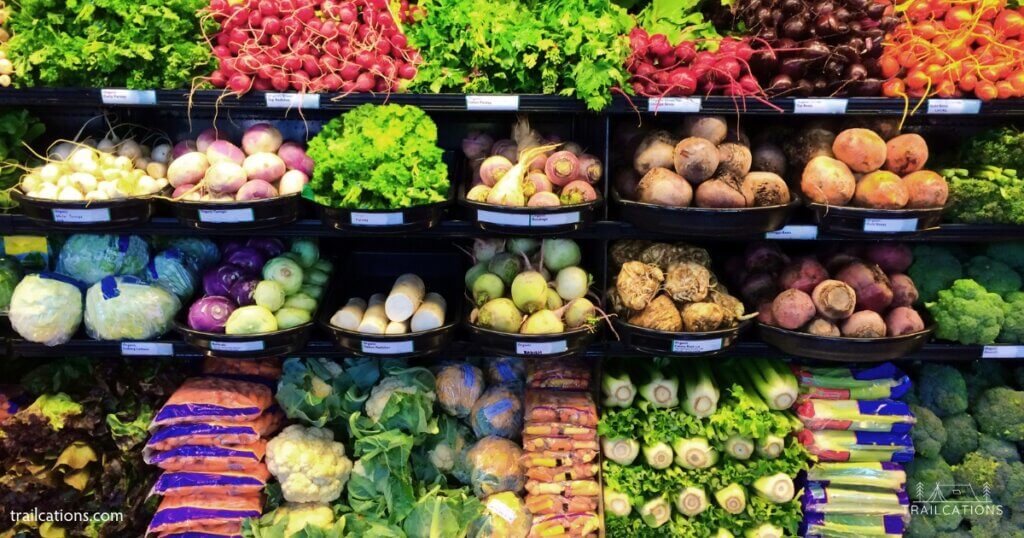
Are Dried Foods Considered Processed?
The US Department of Agriculture (USDA) defines a food as processed if it has undergone any changes to its raw, natural state. This includes any raw agricultural commodity that is washed, cleaned or packaged. It also applies to more complex processes such as canning, freezing, drying or dehydrating.
This being said, dried and dehydrated foods are considered to be ” minimally processed.“ In reality, the majority of food sold in grocery stores is processed according to the USDA standards. Even apples and oranges sold in the produce section are minimally processed in order to preserve nutrients and slow down the spoilage process!
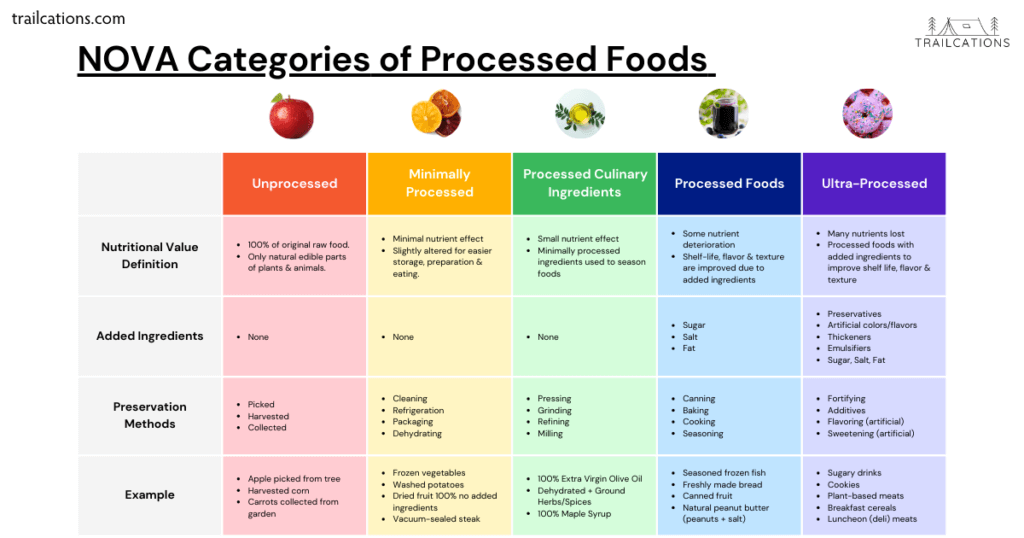
Is Dehydrated Food Considered Processed?
According to the global NOVA definition of a processed food, a dehydrated food is considered to be processed but minimally so. There are 4 levels of processing of food as defined by the NOVA guidelines. From least to most processed foods, the definitions are as follows:
- Minimally processed: Nutritional content of food doesn’t substantially change. Foods are altered slightly to allow for easier storage, preparation and eating. (ex: dried and dehydrated food)
- Processed culinary ingredients: Typically not eaten on their own, these are prepared from minimally processed foods through refining, grinding and pressing. (ex: oils, vinegars)
- Processed foods: Additional additives (like salt, sugar and fats) increase food flavor, texture and durability. (ex: canned vegetables, some cheeses)
- Ultra or Highly processed foods: Additional emulsifiers, thickeners, artificial colors/flavors/sweeteners, etc. are added to processed foods to increase shelf stability and palatability. These tend to be cheaply mass-produced foods that aren’t always healthy. (ex: breakfast cereals, cookies, chips)
What Counts as Ultra-Processed Food?
An ultra-processed food is a processed food with additional ingredients that improve its flavor, shelf life and palatability. These additional ingredients could be preservatives, emulsifiers, thickeners, artificial sweeteners or added colors.
Minimally processed: Home dehydrated fruit made from 100% raw fruit. This is not an ultra-processed food because it contains no extra ingredients. Instead, it is considered as minimally processed.
Ultra-processed: Store-bought dried beef jerky is ultra-processed if it contains preservatives that improved its shelf life (ex: sodium nitrites).
Minimally processed: Homemade dehydrated veggie burgers made from lentils, sweet potatoes, brown rice, lentils and kale
Ultra-processed: Frozen store-bought plant-based meat substitutes made with seasonings and salt
Is dried fruit an ultra-processed food?
The ingredients list and preparation process of the dried fruit determines if it is ultra-processed or not. Ultra-processed foods contain added ingredients such as preservatives, artificial flavorings and sugars. It’s easiest to understand food processing levels with an example:
- Unprocessed: Whole fresh apples
- Minimally processed: Homemade dehydrated apples with no additives
- Processed: Homemade dehydrated apples dusted in cinnamon-sugar and pretreated with ascorbic acid (Vitamin C) to prevent browning
- Ultra-processed: Store-bought dehydrated apples treated with ascorbic acid, cinnamon artificial flavoring and high fructose corn syrup to improve sweetness.
What are 3 Ultra-Processed Foods?
3 ultra-processed foods would be cookies, sugary drinks and luncheon (deli) meats.
Ultra-processed foods are any processed food that contains artificial colors, flavorings, sweeteners, emulsifiers, thickeners and stabilizers. They tend to be mass-produced and use cheap ingredients. Consequently, ultra-processed foods are not always the healthiest.
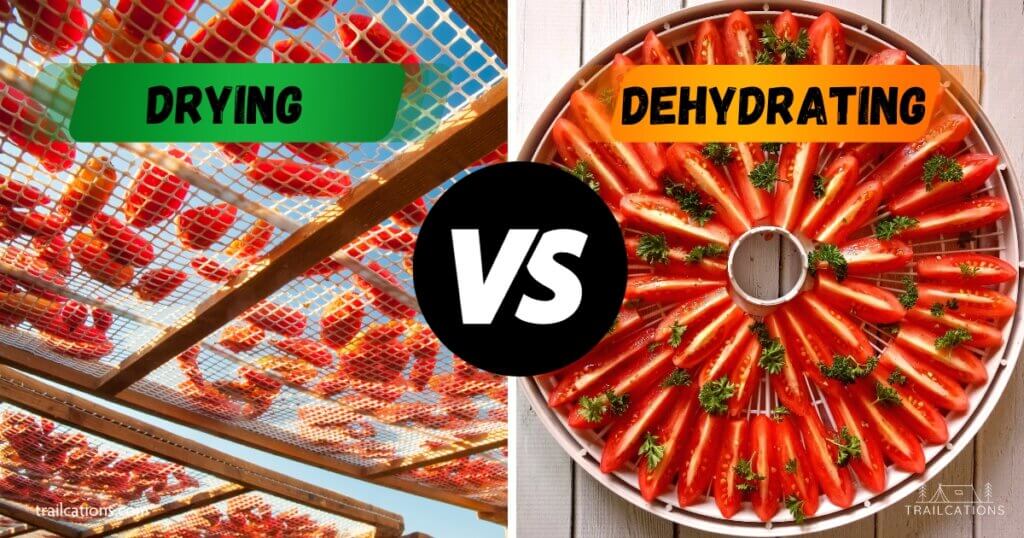
What Are the Advantages of Dehydration Over Drying?
Drying and dehydration are often used interchangeably to described the process of moisture removal using heat and airflow to preserve food for long term storage. However, drying is generally carried out by natural methods (ex: sun or air drying) that take several days. Dehydration removes moisture using artificial heat and airflow under controlled conditions that takes only a few hours to completely dry ingredients.
Dehydration is much more reliable than drying for many reasons. First of all, you don’t need to live a hot, dry, sunny climate to dehydrate food like you do with drying food. If the weather is cloudy, rainy or snowy, you can still dehydrate whereas drying operations would be forced to stop.
Next, dehydration evenly dries the food at optimal temperatures and times to avoid nutrient loss from cooking the food or under drying it. Unlike dehydration, not all foods can be safely air or sun dried because it takes too long and bad bacteria would be able to reproduce and cause foodborne illness.
Finally, dehydration provides consistent, high quality results every time. Drying a food outside using the sun or wind can expose food to pollutants, insects or hungry animals. Some dried foods actually need to be pasteurized before long term storage in case insects laid eggs on them.
Are dried foods healthy?
Air and sun dried food are just as healthy as dehydrated foods in many regards. Dried foods have successfully been preserved using nothing but the sun and wind for thousands of years. However, by modern day food safety standards, not all types of food should be dehydrated, especially if you live in a humid or temperate climate. Avoid drying meats under the sun as they typically cannot be safely dried fast enough to prevent mold and bacterial growth.
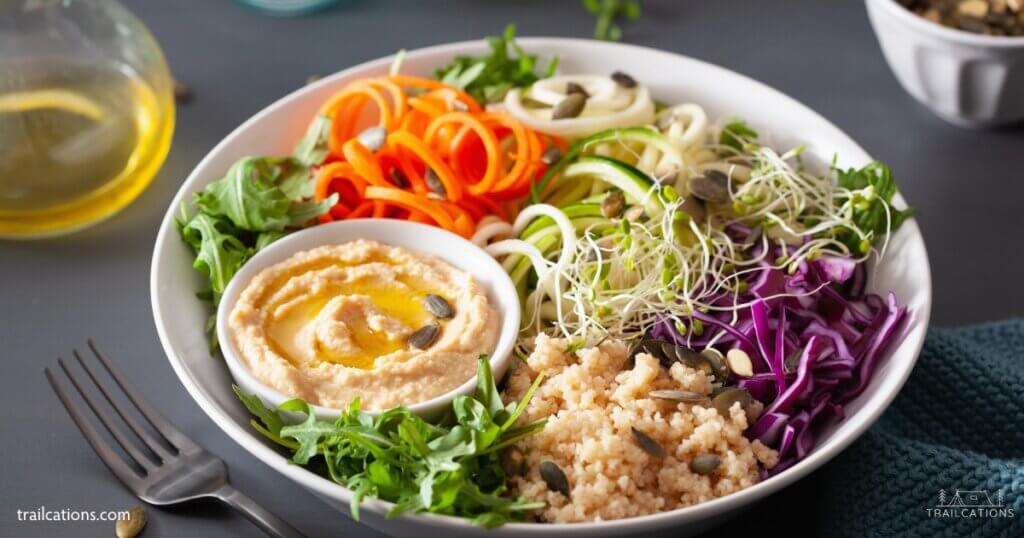
Is Dehydrated Food Still Considered Raw?
Raw food enthusiasts rejoice! Most dehydrated food is considered to be raw, especially if it has been dehydrated at home under a watchful eye (and low enough temperatures).
The raw food diet is comprised of unprocessed and raw foods. A food can be considered raw if it has never been heated over 118°F (48°C) or processed. At those temperatures you can safely sprout grain, dry herbs, fruit and some vegetables.
However, dehydrated meat, fish and jerky needs to be thoroughly heated to an internal temperature of 165°F (74°C). This means that meat cannot be safely dehydrated and considered to be raw food.
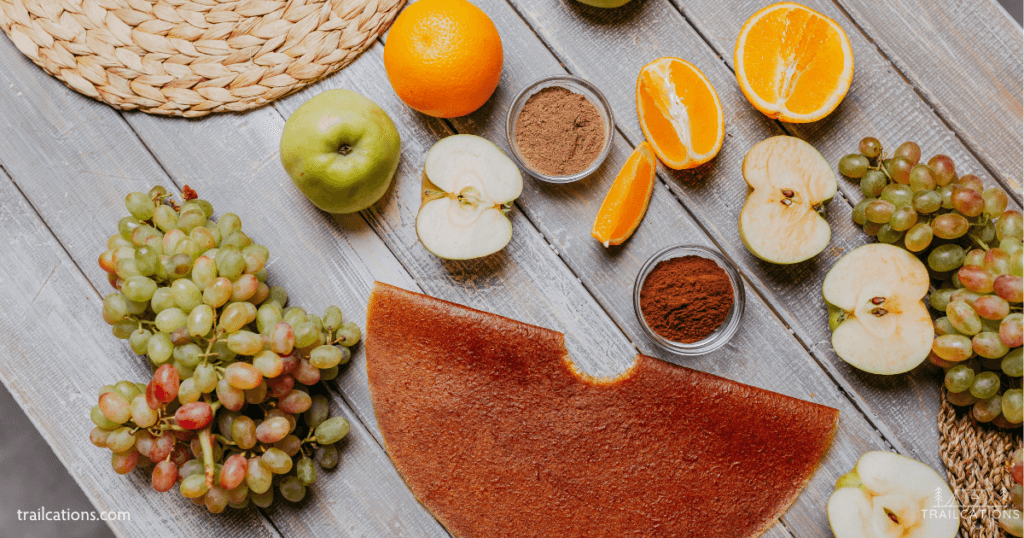
Can You Eat Dehydrated Food on a Raw Diet?
Yes, you can absolutely eat dehydrated food on a raw diet (aka raw vegan diet, raw food diet)!
Raw food dieters follow the belief that cooking food is harmful to your health and avoid consuming any ingredients that have been heated above 118°F (48°C). However, fans of the raw food diet can happily eat most dehydrated food as they have been dried using low temperatures.
Examples of dehydrated food you can eat on a raw diet include foods that successfully and safely dehydrate at lower temperatures. Raw diet dehydrated food includes:
- Fruit: apples, apricots, pears, bananas, cherries, grapes, strawberries, mango
- Fruit leathers: pureed fruit smoothies
- Herbs: basil, dill, cumin, ginger, parsley, thyme, rosemary, chives
- Most Vegetables:garlic, carrots, kale, spinach, peas, corn, broccoli, green beans
- Mushrooms: white button, hen-of-the-woods, lion’s mane, morels, porcini, truffles
- Nuts*: walnuts, peanuts, chestnuts, pecans, almonds
- Seeds*: sunflower, pumpkin, pine, flax, hemp
- Sauces: salsa, raw soy sauce, maple syrup
- Sprouted grains, seeds & legumes: wheatgrass, rye, sunflowers, barley, mung beans
*Dehydrated nuts and seeds should be kept in an airtight container in the freezer or refrigerator long term as their high oil content becomes rancid and spoils quickly.
Keep in mind that you cannot safely dehydrate meat, fish or jerky at such low temperatures as 118°F (48°C). Bad bacteria that cause food poisoning can quickly reproduce if meat isn’t heated to 160-165°F (71-74°C) fast enough. Skip the meat if you want to stay healthy and adhere to the raw food diet.
Frequently Asked Questions
What are the advantages of dehydrated food?
Dehydrated food has several advantages. Firstly, it has a longer shelf life compared to fresh food. Secondly, it is lightweight and easy to store, making it a great option for camping and hiking trips. Thirdly, it retains most of its nutrients and flavor, making it a healthy and convenient option when incorporated into a balanced diet.
What are the disadvantages of dehydrated food?
One of the main disadvantages of dehydrated food is that it can be costly to purchase commercial dehydrated food. Additionally, dehydrated food can be high in sodium and preservatives, especially when purchased from the store. Lastly, dehydrated food may have a different taste and texture compared to fresh food.
How long can dehydrated food last?
Dehydrated food can last for several months to a year, depending on how it is stored. If stored in a cool, dark, dry place in an airtight container, dehydrated food can last for up to a year.
What are some examples of dehydrated foods?
Some examples of dehydrated foods include dried fruits, beef jerky, and dried herbs. Additionally, dehydrated vegetables like kale chips and dried mushrooms are becoming increasingly popular.
Are dehydrated vegetables healthy?
Dehydrated vegetables can be a healthy option as they retain most of their nutrients and fiber. However, it is important to note that some dehydrated vegetables may have added sodium and preservatives, so it is important to read the labels carefully.
How can I use dehydrated food in my cooking?
Dehydrated food can be used in a variety of ways in cooking. For example, you can rehydrate dried fruits and use them in baking or add them to oatmeal for a nutritious breakfast.
Additionally, you can use dehydrated vegetables in soups, stews, and salads for added flavor and nutrition. Dried meats, fish and plant-based meat add protein and textures to meals. Finally, dehydrated sauces, condiments, herbs and flavor powders can improve the taste of bland meals.
How Can a Food Dehydrator Be Used to Preserve Foods and Create Healthy Snacks at Home?
A food dehydrator is a great kitchen tool which can be used to preserve foods and create healthy snacks at home. From delicious dehydrated veggie chips to chewy fruit leathers and savory beef jerky, a food dehydrator is a fantastic appliance for making healthy snacks at home.
Footnotes
- US Department of Agriculture Research Services Division, Composition of Foods – Handbook No. 8, Analysis Charts Table 2 – Nutrients In The Edible Portion Of One Pound Of Food
- https://excaliburdehydrator.com/pages/product-manuals